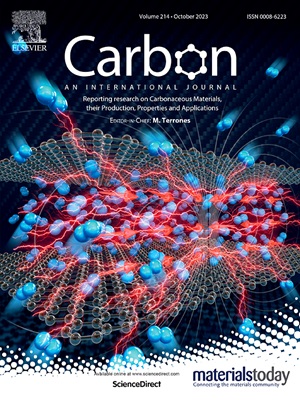柔性HMF/HTC/PEG复合泡沫具有光热转换,能量储存和形状记忆的自适应热管理
IF 10.5
2区 材料科学
Q1 CHEMISTRY, PHYSICAL
引用次数: 0
摘要
相变材料(PCMs)在实际应用中面临着严峻的挑战,包括泄漏、低导热性、刚性和对外部刺激的有限响应性。为了解决这些问题,本研究开发了一种柔性相变复合泡沫(HMF/HTC/PEG),集光热转换、防泄漏、能量储存和光驱动形状记忆功能于一体。以葡萄糖为原料合成水热碳(HTC)颗粒以增强光热转化,而具有三维多孔网络的杂化三聚氰胺泡沫(HMF)作为柔性基体。利用富含羧基的HTC粒子与HMF之间的π-π相互作用,构建了一个鲁棒光热平台。二苯基甲烷二异氰酸酯(MDI)在HMF/HTC框架内进一步交联固定化聚乙二醇(PEG),形成互穿网络防止泄漏。该复合材料具有潜热高、光照下升温快、形状恢复效率高等特点。该材料在热管理方面具有双重功能:在高温环境中吸收多余的热量,并将太阳能转化为储存的热能,以便在寒冷条件下控制释放。其轻质、弹性和形状自适应特性使其在柔性电子产品和节能建筑中的应用成为可能。这项工作提出了一个创新的多功能PCMs框架,弥合了先进储能和自适应热管理技术之间的差距。本文章由计算机程序翻译,如有差异,请以英文原文为准。
Flexible HMF/HTC/PEG composite foam with photothermal conversion, energy storage, and shape memory for adaptive thermal management
Phase change materials (PCMs) face critical challenges in practical applications, including leakage, low thermal conductivity, rigidity, and limited responsiveness to external stimuli. To address these issues, this study developed a flexible phase-change composite foam (HMF/HTC/PEG) integrating photothermal conversion, leakage-proof, energy storage, and light-driven shape memory capabilities. Hydrothermal carbon (HTC) particles derived from glucose were synthesized to enhance photothermal conversion, while hybrid melamine foam (HMF) with a three-dimensional porous network served as a flexible matrix. By leveraging π-π interactions between carboxyl-rich HTC particles and HMF, a robust photothermal platform was constructed. Diphenylmethane diisocyanate (MDI) cross-linking further immobilized polyethylene glycol (PEG) within the HMF/HTC framework, forming an interpenetrating network to prevent leakage. The composite exhibited a high latent heat, rapid temperature rise under light irradiation, and high shape recovery efficiency. The material demonstrated dual functionality in thermal management: absorbing excess heat in high-temperature environments and converting solar energy into stored thermal energy for controlled release in cold conditions. Its lightweight, elastic, and shape-adaptive properties enable applications in flexible electronics and energy-efficient buildings. This work proposes an innovative multifunctional PCMs framework, bridging the gap between advanced energy storage and adaptive thermal management technologies.
求助全文
通过发布文献求助,成功后即可免费获取论文全文。
去求助
来源期刊

Carbon
工程技术-材料科学:综合
CiteScore
20.80
自引率
7.30%
发文量
0
审稿时长
23 days
期刊介绍:
The journal Carbon is an international multidisciplinary forum for communicating scientific advances in the field of carbon materials. It reports new findings related to the formation, structure, properties, behaviors, and technological applications of carbons. Carbons are a broad class of ordered or disordered solid phases composed primarily of elemental carbon, including but not limited to carbon black, carbon fibers and filaments, carbon nanotubes, diamond and diamond-like carbon, fullerenes, glassy carbon, graphite, graphene, graphene-oxide, porous carbons, pyrolytic carbon, and other sp2 and non-sp2 hybridized carbon systems. Carbon is the companion title to the open access journal Carbon Trends. Relevant application areas for carbon materials include biology and medicine, catalysis, electronic, optoelectronic, spintronic, high-frequency, and photonic devices, energy storage and conversion systems, environmental applications and water treatment, smart materials and systems, and structural and thermal applications.
 求助内容:
求助内容: 应助结果提醒方式:
应助结果提醒方式:


